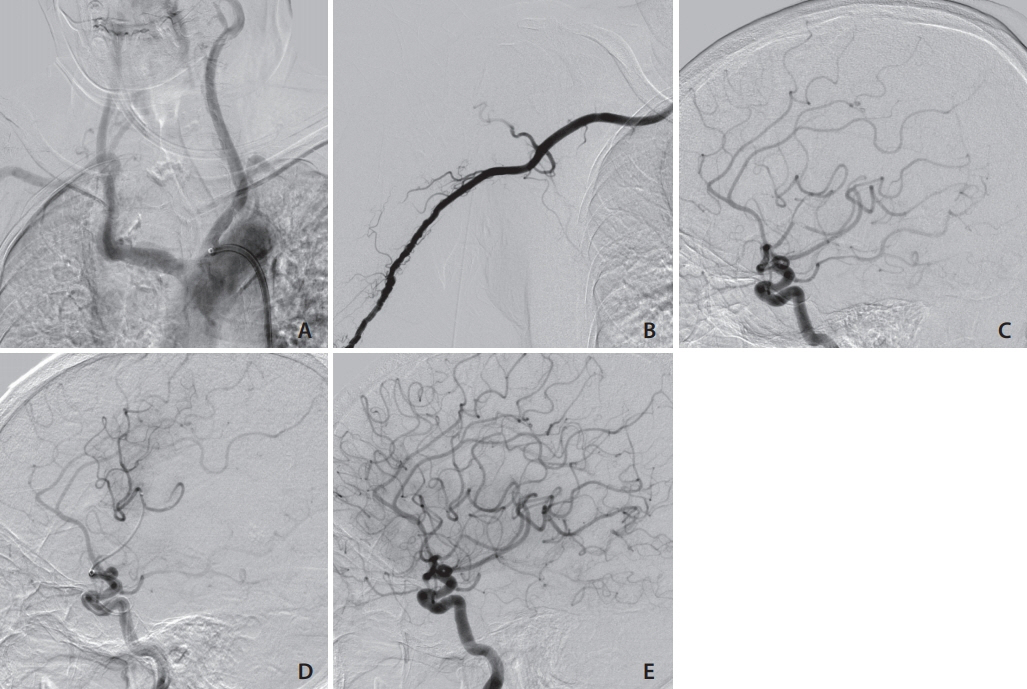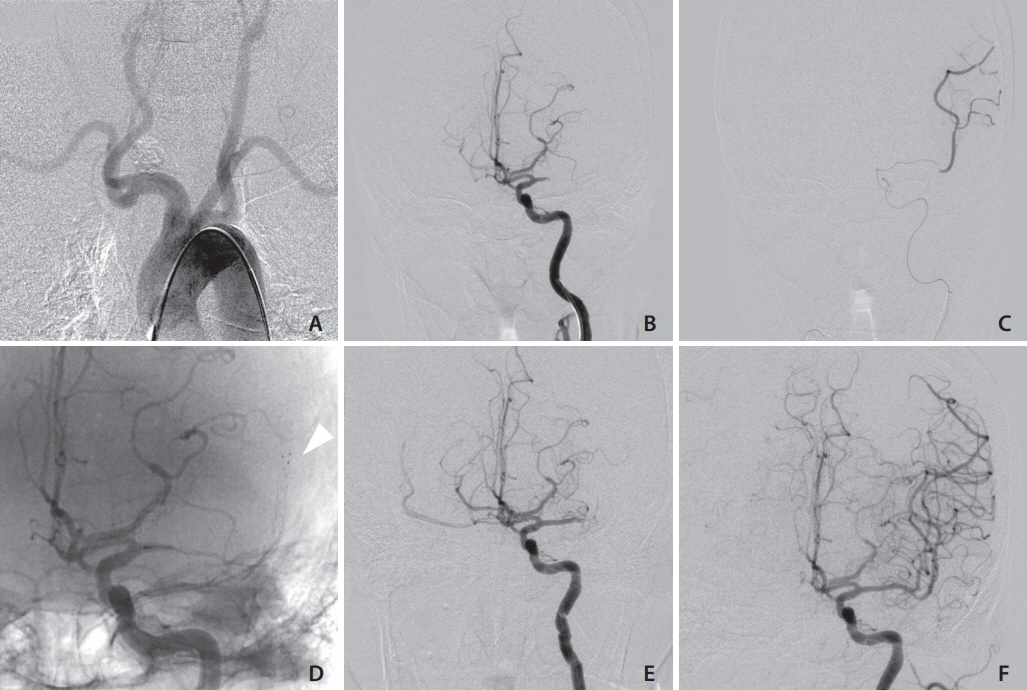Neurointervention.
2020 Jun;15(2):89-95. 10.5469/neuroint.2020.00136.
Mechanical Thrombectomy for Large Vessel Occlusion via the Transbrachial Approach: Case Series
- Affiliations
-
- 1Department of Neurosurgery, Osaka Medical College, Takatsuki, Osaka, Japan
- 2Department of Neurosurgery, Shimizu Hospital, Kyoto, Kyoto, Japan
- KMID: 2503395
- DOI: http://doi.org/10.5469/neuroint.2020.00136
Abstract
- Mechanical thrombectomy has become a standard treatment for acute ischemic stroke with large vessel occlusion. In aged patients, it is difficult to guide the catheter via the transfemoral approach due to vessel tortuosity and aortic elongation. We report our preliminary clinical experience using the transbrachial approach. Among the 119 patients who underwent thrombectomy from April 2018 to December 2019, a total of 5 patients were treated via the transbrachial approach. Clinical outcomes were retrospectively analyzed. Successful reperfusion was achieved in 4 out of 5 cases. There was 1 death due to symptomatic intracranial hemorrhage. One patient had a good outcome at discharge. There were no access-site complications associated with any of these cases. Transbrachial access for mechanical thrombectomy is feasible and can provide an alternative to the transfemoral approach.
Figure
Reference
-
1. ; HERMES collaborators. Endovascular thrombectomy after large-vessel ischaemic stroke: a meta-analysis of individual patient data from five randomised trials. Lancet. 2016; 387:1723–1731.2. Haussen DC, Nogueira RG, DeSousa KG, Pafford RN, Janjua N, Ramdas KN, et al. Transradial access in acute ischemic stroke intervention. J Neurointerv Surg. 2016; 8:247–250.
Article3. Okawa M, Tateshima S, Liebeskind D, Ali LK, Thompson ML, Saver J, et al. Successful recanalization for acute ischemic stroke via the transbrachial approach. J Neurointerv Surg. 2016; 8:122–125.
Article4. Zaidat OO, Yoo AJ, Khatri P, Tomsick TA, von Kummer R, Saver JL; Cerebral Angiographic Revascularization Grading (CARG) Collaborators; STIR Revascularization working group; STIR Thrombolysis in Cerebral Infarction (TICI) Task Force. Recommendations on angiographic revascularization grading standards for acute ischemic stroke: a consensus statement. Stroke. 2013; 44:2650–2663.5. Hacke W, Kaste M, Fieschi C, von Kummer R, Davalos A, Meier D, et al. Randomised double-blind placebo-controlled trial of thrombolytic therapy with intravenous alteplase in acute ischaemic stroke (ECASS II). Second European-Australasian Acute Stroke Study Investigators. Lancet. 1998; 352:1245–1251.6. Criado FJ. Mastering carotid intervention: what you need to know before performing your next CAS procedure. Endovascular Today. 2003; 9:65–68.7. Saver JL, Goyal M, van der Lugt A, Menon BK, Majoie CB, Dippel DW; HERMES Collaborators. Time to treatment with endovascular thrombectomy and outcomes from ischemic stroke: a meta-analysis. JAMA. 2016; 316:1279–1288.
Article8. Ribo M, Flores A, Rubiera M, Pagola J, Mendonca N, Rodriguez-Luna D, et al. Difficult catheter access to the occluded vessel during endovascular treatment of acute ischemic stroke is associated with worse clinical outcome. J Neurointerv Surg. 2013; 5 Suppl 1:i70–i73.
Article9. Sur S, Snelling B, Khandelwal P, Caplan JM, Peterson EC, Starke RM, et al. Transradial approach for mechanical thrombectomy in anterior circulation large-vessel occlusion. Neurosurg Focus. 2017; 42:E13.
Article10. Matsumoto H, Masuo O, Takemoto H, Kawabe R, Hirohata Y, Itakura T. [Carotid artery stenting via the transbrachial approach]. JNET. 2007; 1:40–44. Japanese.
Article11. Montorsi P, Galli S, Ravagnani PM, Trabattoni D, Fabbiocchi F, Lualdi A, et al. Carotid artery stenting in patients with left ICA stenosis and bovine aortic arch: a single-center experience in 60 consecutive patients treated via the right radial or brachial approach. J Endovasc Ther. 2014; 21:127–136.
Article12. Sakamoto S, Matsushige T, Abiko M, Shimonaga K, Hosogai M, Okazaki T, et al. Navigation of a 6-French guiding sheath into the common carotid artery using a tri-axial catheter system in transbrachial carotid artery stenting. Interv Neuroradiol. 2019; 25:38–43.
Article13. Matsuda Y, Terada T, Masuo O, Matsumoto H, Ohshima K, Tsumoto T, et al. The clinical results of transcervical carotid artery stenting and frequency chosen as the approach route of carotid artery stenting in 1,067 consecutive cases. Acta Neurochir (Wien). 2013; 155:1575–1581.
Article14. Shibata T, Oomura M, Nishikawa Y, Mase M. Direct brachial approach for acute basilar artery occlusion: technical note and preliminary clinical experience. Neurointervention. 2020; 15:31–36.
Article15. Nguyen TN, Malisch T, Castonguay AC, Gupta R, Sun CH, Martin CO, et al. Balloon guide catheter improves revascularization and clinical outcomes with the Solitaire device: analysis of the North American Solitaire Acute Stroke Registry. Stroke. 2014; 45:141–145.
Article16. Koge J, Iwata T, Hashimoto T, Mizuta S, Nakamura Y, Tanaka E, et al. Carotid artery stenting with proximal embolic protection via the transbrachial approach: sheathless navigation of a 9-F balloon-guiding catheter. Neuroradiology. 2018; 60:1097–1101.
Article17. Kiemeneij F, Laarman GJ, Odekerken D, Slagboom T, van der Wieken R. A randomized comparison of percutaneous transluminal coronary angioplasty by the radial, brachial and femoral approaches: the access study. J Am Coll Cardiol. 1997; 29:1269–1275.
Article18. Webber GW, Jang J, Gustavson S, Olin JW. Contemporary management of postcatheterization pseudoaneurysms. Circulation. 2007; 115:2666–2674.
Article19. Mizokami T, Uwatoko T, Furukawa T, Higashi E, Sakaki Y, Suetsugi N, et al. Transradial approach for mechanical thrombectomy of posterior circulation stroke. J Neuroendovascular Ther. 2018; 12:314–319.
Article
- Full Text Links
- Actions
-
Cited
- CITED
-
- Close
- Share
- Similar articles
-
- Suction thrombectomy of distal medium vessel occlusion using microcatheter during mechanical thrombectomy for acute ischemic stroke: A case series
- Alternative Transcarotid Approach for Endovascular Treatment of Acute Ischemic Stroke Patients: A Case Series
- Differences in mechanical thrombectomy for acute ischemic stroke on weekdays versus nights/ weekends in a Japanese primary stroke core center
- Mechanical Thrombectomy for Septic Embolism Secondary to Staphylococcus lugdunensis Bacteremia without Infective Endocarditis: A Case Report
- Novel use of a stent retriever as a distal filler protection device for prevention of secondary embolization



